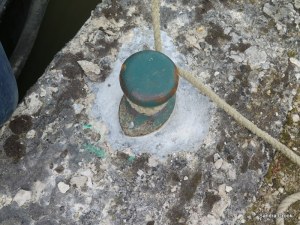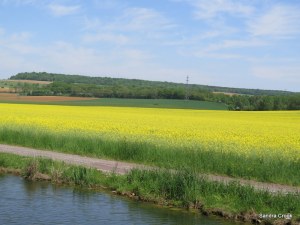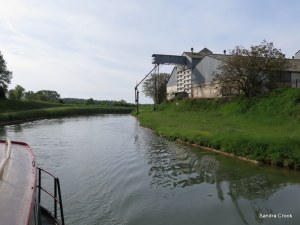Setting out on 30th April, we’d stopped at Gigny and Gergy on the way up the Saone before having to take haven at Seurre for five days because of serious flooding right through the waterways of France (see https://castelsarrasin.wordpress.com/2015/05/04/water-water-everywhere/). Seurre is not the best place to be stranded for a protracted period, at 17 euros a night, and with internet only available in the capitainerie itself, or by our own very slow SFR connection. Worryingly, we were using up a lot of our 12 gig monthly allowance monitoring weather forecasts and Vigicrues – the website monitoring French river levels.
- Water levels on our arrival at Seurre.
- Water levels when we finally decided to risk continuing
By 7th May the water levels were still up at Seurre, but the outlook further upstream was better with levels dropping quickly, so we decided to risk it and made reasonable progress past Auxonne where the marina had been badly affected by the floods, the breakwater of having been breached. We reached Pontailler by mid-afternoon, where we moored on a fast flowing bend of the river.
The next day we entered the Canal Entre Champagne et Bourgogne with some relief. It was good to be off the river. The instructions for locking are on a board as you enter the lock; basically you enter the lock, push the blue rod and when ascended you press the button on the lockside which prompts the operator to dispense a remote control (hereinafter ‘zapper’) from the machine there, and to take some details from you. Impressive! You don’t immediately need to use it as several locks are linked initially. But the first time we needed to, a lockie turned up to monitor our first encounter. And that really was the watchword for this canal, which is a very service-orientated waterway with customer care that is unobtrusive and second to none. There are a number of adequate moorings along this initial stretch, Maxilly, Cheug, Reneve, Oisilly but ultimately we moored wild just above lock 36 at Blagny. No facilities but pilings and fairly deep on right bank.
Many of the locks along here have a pair of dolphins stationed on either side of them, with passarelles extending to the bank, supposedly for peniches but frankly we didn’t meet any commercial craft until the very last day on the canal. You’ll see, several hundred yards before each lock, a blue sign indicating that you should use your remote control to action the lock. The bollards on the control box lockside were occasionally set too far apart for us, so sometimes we’d push the boat across to reach the rods. We moored at Villeneuve sur Vingeanne at the disused silo. The building is in a bad state of repair, so I’d be careful if mooring here with children on board as the access to the silo is open. Adequate mooring, no facilities but quiet. We tied to one mooring ring and the end of the chute support.
Many of the locks today had been fitted with additional new bollards to make life easier for  shorter craft (symptomatic of the thought and care that has gone into rendering this waterway extremely user-friendly), but the bases or plinths of some of these are pointedly ovoid, parallel to the lock edge and it can be difficult for rope management if the rope drops below the neck of the bollard onto the base. It’s not easy to see this from the bottom of a 3.5m lock and the first indication you get is when you can’t tighten your rope!
shorter craft (symptomatic of the thought and care that has gone into rendering this waterway extremely user-friendly), but the bases or plinths of some of these are pointedly ovoid, parallel to the lock edge and it can be difficult for rope management if the rope drops below the neck of the bollard onto the base. It’s not easy to see this from the bottom of a 3.5m lock and the first indication you get is when you can’t tighten your rope!
The locks are quite deep, generally 3.5m and even Neville, at over 6′ had to stand on the roof of the back cabin to even attempt to secure the rope to the bollard with a boat-hook. I’m much shorter, so sadly, because it slows our progress, I had to be put ashore at the mouth of the lock on some stretches. But again, there are a whole array of alternatives to suit different crafts/skills. You can step off, climb the ladders inside, and even push the blue pole manually if the zapper doesn’t work.
 We cruised on, between glowing rape fields beneath fiercely blue skies, and at Ecluse 24 we left the Bourgogne region and entered Champagne-Ardennes, leaving the Cote d’Or behind as we passed into Haute-Marne.
We cruised on, between glowing rape fields beneath fiercely blue skies, and at Ecluse 24 we left the Bourgogne region and entered Champagne-Ardennes, leaving the Cote d’Or behind as we passed into Haute-Marne.
We’d identified Cusey as a possible place to fill up with water (we like to keep our water tanks pretty well topped up whilst cruising) but none of the services had been initiated this early in the season. This would be a lovely little mooring in season, and well worth incorporating in your schedule.
As we were hunting around determining the state of affairs, a lockie pulled up, and asked if we were staying here. We said we’d only stopped for water and he said there was a robinet at Ecluse 22. When we reached there, he was waiting for us with the water hose unwound and brought to the lockside.
From here on, we tended to use the blue pole in the lock to start the filling cycle, as the ‘bassinez’ button on the zapper didn’t seem to be working.
We pulled up for the day at Dommarien, just before the lock. Lovely little village with
absolutely no services, but a beautiful old wash-house by the river and a curious goat. What looks like a 50-60 metre recess is in fact sloping sided, but a short 10 metre quay has been erected at one end. No fishermen were in possession of this quay at the time we arrived, just around lunchtime, but a lot of white vans drove up, and then roared away spitting gravel when they saw us there. Boaters 1- Fisherman 99. 🙂 A lockie called by early evening to find out our plans. The locks are open 7 to 7 for commercials, and 9 to 7 for plaisanciers, but on this stretch (unlike later stretches) the lockies were happy to accommodate earlier starts and we were away by 8.00am most mornings.
 The next dawned bright and beautiful with temperatures set to reach 27 deg C and we continued through beautiful countryside. I told the new lockie that we’d halt temporarily at Piepape for bread but would then continue on until the tunnel at Heuilly-Cotton. At the next lock the same lockie turned up and told me that the boulangerie at Piepape closed at 9.00am, but he’d take me there in his van while Neville single-handed up to the next lock. How kind was that? The boulangerie was a fair distance from the lock, and we’d have been frustrated to find it closed after walking all that way.
The next dawned bright and beautiful with temperatures set to reach 27 deg C and we continued through beautiful countryside. I told the new lockie that we’d halt temporarily at Piepape for bread but would then continue on until the tunnel at Heuilly-Cotton. At the next lock the same lockie turned up and told me that the boulangerie at Piepape closed at 9.00am, but he’d take me there in his van while Neville single-handed up to the next lock. How kind was that? The boulangerie was a fair distance from the lock, and we’d have been frustrated to find it closed after walking all that way.
We banged one of our zig-zag fenders on entering one lock. Always wondered which part of the fitting would give way under impact: the wire, the steel ferrule it’s attached to, or the fender. It was the fender, the wire cut straight through. 😦
We ascended the last eight very deep locks to the summit. In keeping with the rest of this canal, everything is thoughtfully arranged. There are inset bollards on the lock walls, plus quayside bollards. The spacing is different from lock to lock but one way or another most boaters can be accommodated. After we encountered one lock where after using the inset bollard for the initial stages of filling, we had to move the boat to transfer the rope to a quayside bollard, I decided I’d cycle between locks and take the ropes from the quayside. At the top we indicated, when asked, that we’d stay overnight before the tunnel and set off early next morning to go through. There is a small stretch of quay right below the digital sign for the tunnel entry, and we moored there – a very quiet spot. Another lockie arrived to determine our plans, and it was agreed we’d start through the tunnel at 8.00am, using the zapper to get a green light at the entrance. I’m not a tunnel fanatic – we once got stuck in our narrowboat in Harecastle Tunnel in the UK, when a plastic bag wrapped itself round our props, and we regularly had to use the Braunston tunnel for many years. We’ve also done the Pouilly tunnel three times in the last two or three years – and that’s notoriously ill-lit.
But next morning we entered the tunnel a few minutes after 8.00am and had a pleasant surprise. It’s well lit from the left above a reasonable walkway, with telephone contact points at regular intervals. There’s good headroom and width. An optical illusion of something in the water channel, which alarmed both of us simultaneously, turned out to be the other end of the tunnel! We also noted several other ‘obstructions’ which turned out to be reflections of the overhead fans. It’s 4.8 kilometres, so a bit boring, but we didn’t have any sharp encounters with the sides.
Emerging into bright sunshine, we were now ready for a change to some downhill locking. We’d indicated an intention to stop for the day at Langres where we knew there was a supermarket, but our visit proved abortive. Electricity is available but only three times a day, from 0700-0800, 1200-1300 and 1900-2000 The sign at the mooring indicated shops at 1 km but no indication as to direction and after cycling up a couple of steep hills in the wrong direction we gave up and pressed on. Lovely port though, well laid out, and a restaurant quite close by. We were able to top up with water which thankfully does not have a timetable for availability.
From Langres, after one more zapper controlled lock, you need an accompanying lockie from locks 4 to 22. Theoretically you need to book this lockie before 3.00pm for the following day. Not sure what kind of arrangement my telephone dialogue with the lockie had culminated in (why is a foreign language always rendered more baffling through the media of radio/telephone?) we went down the first lock and eventually a woman turned up to manually operate the locks, with a bit of help from us.
Lock 7 had been almost totally renovated, relined walls, new inset bollards and one big plus – shiny steel curved edges to the quaysides which will save a fortune in rope wear.
We arrived at Rolampoint at 4.30pm. Lovely litle mooring with tree-shade, and water and electricity both free. An excellent supermarket, Cocci, can be found by going back to the bridge, turning right and right again on the road to Chaumont. About 2-3 minutes bike ride up that road. There is a bar/bistro on the mooring side of the canal and a hotel restaurant in the town itself. A thriving, bustling town. Would have loved to stay here longer. There are two boulangeries in this town, one on the moorings side, and one in the town.
The attitude to early starting has changed along this stretch. An early start means 9.00am along here, and there is a mandatory lunch break! But again, when it was time for her break, we were handed to another lockie who’d already had his, so were able to continue. This English speaking lockie was very helpful too. All lockies along here wear life-jackets as standard. We continued on as the weather deteriorated and arrived in Chaumont around 3.15. A long day with 15 locks in all.
Chaumont is a nice, well-run mooring with concrete bollards. It’s advertised as having internet but that only works in the capitainerie. 9 euros a night plus 2.35 for electricity here. You walk up the hill to find amenities but the grey clouds culminated in violent winds and rainstorms so we didn’t have a chance to explore. It’s a pity we are so far behind our schedule for the intended ‘ring’ of canals.
On leaving Chaumont, after the first lock and a lift bridge you go through the 300m Condes Tunnel which illuminates automatically as you enter. At Lock 27 the lift bridge about 40 metres after the lock mouth opens in conjunction with the gates.
There are some potentially nice moorings at Riaucourt (Lock 29) on the left bank below the lock (or on the dolphins above the lock).
At lock 29 the red and green lights lit up on command, but with the green flashing, as someone was coming out of the lock. For what seemed ages after the other boat had gone the lights remained flashing instead of changing to steady green, so we decided to chance it and enter. Big mistake – wouldn’t work and we finally decided we should have waited, as it was waiting for us break the beam at the lock entrance. Reversed partially out of the lock, re-entered and everything was fine.
A lockie, (they always seemed to know exactly where we would be and at what time), joined us to take us through the lift bridge at Vieville. There are several lift bridges along here, some operating with the zapper, others being set by a lockie.
We arrived at Froncles around 2.30pm. We’d heard this lovely spot is frequently unavailable due to wintering or longer term moorers hogging the quay, so we weren’t hopeful. In fact less than half the very lengthy quay was taken up by three smallish boats, and we (17m) plus another big boat of similar length and a yacht were able to moor here, leaving space for one more if we’d squeezed up. Lovely mooring, heavily wooded hillside to the right and the village to the left with usual amenities, pharmacy, two boulangeries and a Carrefour Express. You reach the village via the green bridge near the capitainerie and through the activities park. A sizeable camper van facility here, right by the quay. There is a second, short quay by the VNF depot a couple of hundred metres or so down from the main mooring if you can’t get in at Froncles.
The next day we passed nice moorings at Villiers sur Marne, and at Donjeux. The countryside round here is lovely, rolling hills, wooded slopes and panoramic views.
We arrived at Joinville around 1.00pm. The first mooring you reach is a quay with a pretty garden, quite near to a VNF compound in a fairly industrial area. Here there is a Lidl within easy walking distance and, I believe a sysem for obtaining electricity on a metered basis, a facility shared with camper vans.
We moored up behind a burned out boat; you could still smell the charring, so I guess it was a recent event. Certainly police arrived to examine the wreck whilst we were lunching.
Afterwards Neville cycled up the towpath to check another mooring a few hundred metres up the canal at a privately run mooring at a gite/hotel/restaurant. There was proper electricity and water arrangements, plus internet, so we moved up the canal. Definitely recommend this moring at 8 euros per night inclusive.
This stretch of the waterway was heavily weeded;
we and other boats ended up with it wrapped round our props and bow thrusters whilst descending into Joinville, but we managed to clear it.
The next morning we woke to fog, which eventually cleared as the sun rose. A yacht set off at the same time and we continued together through a series of locks and lift-bridges throughout the morning. They were still suffering with weed round the prop, which eventually, using our longer boat-hook they managed to clear.
 We continued through a lovely rural landscape, cows stopping to stare as we disturbed their ruminations.
We continued through a lovely rural landscape, cows stopping to stare as we disturbed their ruminations.
The lift bridges seem to have a variety of handling mechanisms. At some a lockie is waiting for you (excellent timing – never had to wait), others work from the zapper, some from detectors, and still others have the hanging perch arrangement. At one, which had a perch pole, the lockie was there at the bridge controls, which was a lucky thing as I’d surmised that the boat in front twisting the perch would activate the road bridge for both our boats. (I assumed that there would be some kind of a detector on the banking.) We were stunned then when, only metres away, the light turned red. Too late to stop we sped through, and later I was ‘gently’ reprimanded by the same lock-keeper (who had manually intervened to stop the bridge closing, it turned out – thus turning the light red). “Deux annonces” at the lift bridge, it seemed. This isn’t the case on a lot of perches, where only one twist is mandatory.
At 2.00pm we arrived at Chamouilly – a lovely mooring on a wide bend between two bridges and next to a town park. There’s a pump-out here, plus electricity on a meter/credit card arrangement. There’s even a talking husky in a cottage nearby. Our afternoon was punctuated with “mnyom, mnyom, aruvyou” husky-speak until he was finally taken out for a walk early evening, and allowed to stand on a picnic table for an hour or so. There is a small Proxi supermarket close to the mooring where bread can also be obtained.
We continued on towards St Dizier. At the second lock a VNF man arrived and hung around, obviously anticipating some kind of problem. It materialised, with the doors not opening at the end of the cycle, and he was able to intervene manually – before moving on ahead of us to operate the swing bridge below lock 57. No time lost. It’s those little touches along this canal that have really made it special. He’d obviously known where we were moored and at 9.00am was out on the towpath looking for us. This lift bridge is immediately followed by a swing bridge which is a tad difficult with a projection on the LB at the end of the narrows.
The port at St Dizier is undergoing massive refurbishment and will be a really terrific mooring place when finished – cobbled sets, new bollards, long quay. The lock has curved steel edgers and the mooring is opposite a fitness centre with a swimming pool. Below the lock there is a mooring next to a dilapidated factory, and a small mooring 500 metres or so further along on the right.
At lock 59 and for several locks thereafter there is no blue control rod mechanism. You just point the zapper at the steel pole on the hut at the side. Along this stretch you might be entertained by Mirage fighter jets on manoeuvres here from the aerodrome St Diziers-Robinson. Earplugs might also be necessary. After lock 60 you embark on a long straight stretch which at first runs parallel with the aerodrome.
Our last night on the Champagne et Bourgogne was spent at Orconte, a pleasant rural mooring with showers, press button water and electricity (though we could only get the two-pin working). It’s about 1K to the village where I understand there is a boulangerie. Someone comes from the Mairie to collect 8 euros towards early evening. It seems that here you pay the 8 euros whether you have electricity or not, as our yachtie friends arrived later and had to pay just for mooring alone. You can moor on the opposite side, closer to the lock (proper bollards) for no charge with no services.
Next morning there was a very strong gusting wind, and we had an immediate sharp encounter with the lock entrance a few yards away – a real cupboard-door opener! Nice start to the day.
 Along this stretch we saw the first large commercials and dredgers of this part of the trip and had a minor moment of excitement negotiating between them all, tackling a low arched bridge at the same time. This would, of course, happen on one of the windiest days so far.
Along this stretch we saw the first large commercials and dredgers of this part of the trip and had a minor moment of excitement negotiating between them all, tackling a low arched bridge at the same time. This would, of course, happen on one of the windiest days so far.
We left the Canal Entre Champagne et Bourgogne at 11.00, passing the moorings at St Vitry le Francois. This looks like it might be a difficult mooring for some boats, though there were some linear moorings that would accomodate a boat of our size. There is a boatyard here.
- St Vitry le Francois
- Linear moorings at St Vitry le Francois
We really enjoyed this stage of our spring cruise. There are not many shopping opportunities along here, so make sure you are well stocked up on essentials. The locks were in good condition, with new fittings and many had been modified to cater for leisure-boaters. I really appreciated the curved steel lock-edgers which are such a help in preserving your ropes. There’s obviously a big effort being made to attract the tourist market. We’d had nice, if not always warm weather, there had been some beautiful countryside, and best of all the service was second to none. We had the feeling that the lockies were monitoring our progress all the time, and turning up where and when they knew they would be needed. Unlike some canals, we didn’t feel we had to commit ourselves to a schedule all the time – if there wasn’t a need for lockie intervention (swing or lift bridges) they just simply let us come and go, stop and start as and when we wanted to. That was lovely! Full marks to the administration of the Canal Entre Champagne-Bourgogne. And thanks for making our journey such an enjoyable and friendly experience.
During the next stage of our journey, my computer crashed following a Windows update. Unfortunately I’d downloaded a lot of photographs from both my cameras, and cleared the memory card of one of them. So a lot of the photos for this part of the trip were lost. Apologies for what, to me, seemed a limited photo display of a very beautiful canal. 😦 I can only recommend you see it for yourself.























































Nice Sandra !
LikeLike
Thanks Bill. Hope you’re well.
LikeLike
Doing OK 🙂 – Jan and I are planning our next chance to stow-away 🙂
Getting a bit of bike riding in. I really enjoyed this post. It piqued my interest for a heroine and her intrepid husband solving murders on the canal 🙂
LikeLiked by 1 person
Really enjoying your stories. We should be setting off for France next spring so as well as enjoying a read your blog is giving us such wonderful information to help us in our planning. I look forward to the next episode. Thanks you – Jo
LikeLiked by 1 person
So pleased you find them interesting. I’m just about to start on the report on the Marne au Rhin, but trying to locate photos with the mess my computer’s currently in… daunting. 😦 Look forward to reading about your adventures when you get underway.
LikeLike